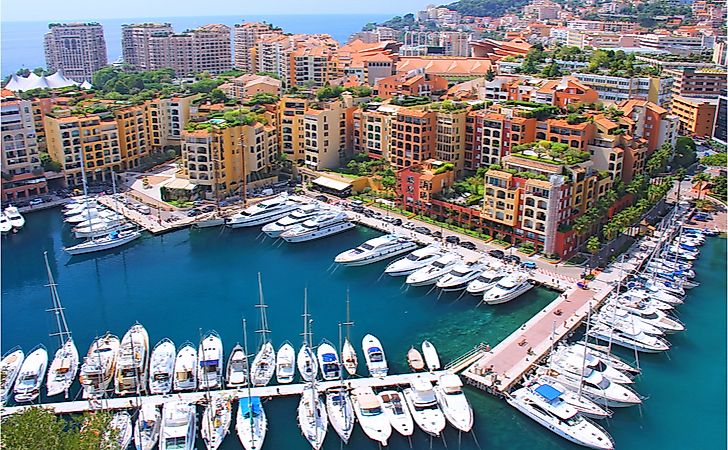What Are The Major Natural Resources Of Monaco?

Monaco is a European state with one of the best economies globally. In 2017, Monaco's GDP per capita was ranked as the 2nd highest in the world at $165,421. Monaco has managed to achieve economic success despite the few economically viable resources in the country. Some of Monaco's most critical natural resources include fish and the country's beautiful scenery.
Fish
One of Monaco's essential natural resources is fish which are mainly obtained from the Mediterranean Sea. Monaco's coastline in the Mediterranean Sea stretches for roughly 2.38 miles and the country has a maritime claim of approximately 13.8 miles into the sea. Monaco also has an exclusive economic zone of about 12 nautical miles. Some of the fish species found in Monaco's territorial waters include the bluefin tuna, European conger, and Atlantic bonito. Despite the vast array of fish species found within Monaco's territorial waters, the fishing industry is one of the country's minor sectors as it only employs a small segment of the workforce. Fishing in Monaco can be classified into two main categories, commercial fishing, and sports fishing. Overfishing is considered one of the significant challenges facing Monaco's fishing sector. The Monacan government has taken several steps to address the issue of overfishing in the country. In 2009, the Monacan government nominated the Atlantic bluefin tuna to be considered a protected species. Monaco's proposal was supported by several nations such as the US and opposed by other nations such as Italy, France, Greece, and Spain. The countries opposed Monaco's proposal because of the importance of tuna fishing to their economies.
Sports Fishing
Monaco is considered one of the premier sports fishing destinations in the world because of the vast array of fish in its territorial waters. Sports fishers are also attracted to Monaco because of the clear waters. One of the most popular forms of sports fishing in Monaco is bluefin tuna tagging which mainly occurs 15 to 20 miles away from the shore. Bluefin tuna tagging is considered the best method of catching the species in the Mediterranean. Several companies have been set up to cater to a large number of sports fishers who visit Monaco each year.
Commercial Fishing
The commercial fishing sector is considered one of Monaco's minor sectors. In 2003, the Monacan government estimated that the country's commercial fishermen had caught roughly 3,000 tons of fish. Commercial fishers in Monaco mainly fish for lobsters such as the Norway lobster which is commonly referred to as the Lengustina. The Norway lobster is mainly caught by trawling and sold to hotels. Despite the presence of a vibrant fishing industry, Monaco is forced to import much of the fish consumed within its borders.
Aquaculture
Fish farming is considered one of Monaco's essential economic activities. The Monacan government estimated that on average, the country's fish farms produced 800 tons of fish each year. Most of the fish from Monaco's fish farms are consumed locally. Some of the fish reared in Monaco's fish farms include sea bass and sea bream. One of the major companies involved in the Monacan fish farming sector is Pisciculture Marine de Monaco which runs an offshore fish farm with almost 100 employees. The Monacan government has invested heavily in marine science to improve the country's fish farming sector.
Livestock
Because of Monaco's small size, the number of livestock kept in the country is limited. However, Monaco has a vibrant dairy sector that primarily serves the needs of the local population. Some of the milk produced in Monaco is exported to other nations. In 2005, the Monacan minister of agriculture, Peter McGauran set up regulations to govern milk exports from Monaco. The regulations were aimed at improving the standard of dairy products exported from the country.
Beautiful Scenery
One of Monaco's most critical natural resources is its beautiful scenery that draws large numbers of tourists to the country each year. Some of the most beautiful destinations in Monaco include the country's beaches, gardens, and cities. The tourism industry is considered one of the primary drivers of the Monacan economy because of its significant contribution to the country's GDP. In 2007, the Monacan labor department estimated that the tourism industry employed roughly 11.64% of the Monacan labor force. Several challenges face Monaco's tourism sector such as the decline in the value of the British Pound which reduced the number of British visitors to the country and the high value of the Euro that led to a reduction in the number of American visitors.
Gardens
Some of the most popular tourist attractions in Monaco are the gardens which include the Jardin Exotique and the Saint-Martin Gardens. The Jardin Exotique is situated on a Cliffside and is considered amongst the most beautiful gardens in Monaco. Some of the plants in the Jardin Exotique were brought to Monaco from Mexico during the 1860s. The plants were later placed under the care of Augustin Gastaud, one of Monaco's premier gardeners. During the early 20th century, the Prince of Monaco bought some land and commissioned the construction of the gardens. Plants from Africa were later added to the gardens during the mid-1950s. Another famous garden in Monaco is the Jardin St. Martin which is situated in Monaco-Ville. The garden is famous as it has a statue of Prince Albert I which was designed by François Cogné.
Challenges Facing Monaco's Economy
The Monacan economy faces several challenges such as the country's small size and its overreliance on the tourism industry. The country's small size is a significant hindrance to the development of several industries. The overreliance on the tourism sector leaves Monaco vulnerable to economic shocks that may limit people's ability to travel to the country. The Monacan government has put in place several policies to diversify the country's economy to deal with the challenges it faces.











